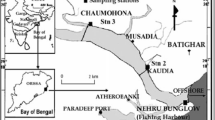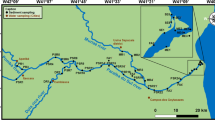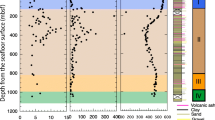Abstract
The behavior and dynamics of arsenic at Ilha do Mel, Guaraqueçaba, and Paranaguá, located in the Paranaguá Estuarine Complex, Brazil, were investigated in this work. Samples were collected in March, September, and December of 2005. With respect to arsenic behavior, the total concentrations were higher for Paranaguá (22.5 ± 2.5 μg L−1) on average, followed by the samples of Guaraqueçaba (14.4 ± 3.2 μg L−1) and Ilha do Mel (8.7 ± 1.1 μg L−1). The concentrations found in this work were consistently greater when compared to other estuaries. The results can be attributed to geological factors. Nevertheless, it was also possible to realize that higher concentrations were found in Paranaguá, the more impacted environment. These results represent a strong indication that human activities in the area contribute to the enrichment of the estuary with this metalloid. Arsenic was mainly present in the dissolved phase, which corresponded to more than 70% of the total concentration. This behavior can represent a greater residence time of this metalloid in the water column. The marine phytoplankton presence was decisive in dictating the distribution of As in the waters of Paranaguá estuary. Organic species, which are considered the less toxic, were found in higher concentrations in the eutrophic areas such as Guaraqueçaba and Paranaguá. This was a typical behavior during the summer probably due to higher biological activity.






Similar content being viewed by others

References
Andreae MO (1978) Distribution and speciation of arsenic in natural waters and some marine algae. Deep Sea Res 25:391–402
Andreae MO, Andrae TW (1989) Dissolved arsenic species in the Sheldt estuary and watershed, Belgium. Estuar Coast Shelf Sci 29:421–433
ATSDR (2007) Toxicological profile for arsenic. U. S. Department of Health and Human Services, Public Health Service. Agency for toxic substances and disease registry, Atlanta. http://www.atsdr.cdc.gov. Accessed May 2010
Benoit G, Rozan TF (1999) The influence of size distribution on the particle concentration effect and trace metal partitioning in rivers. Geochim Cosmochim Acta 63:113–127
Carmouze JP (1994) O metanolismo de ecossistemas aquátivos: fundamentos teóricos, métodos de estudo e análises químicas. Edgard Blücher, FAPESP, São Paulo
CERCLA (2007) Priority list of hazardous substances ATSDR. http://www.atsdr.cdc.gov/cercla. Accessed May 2010
Chou CHSJ, de Rosa CT (2003) Case studies—arsenic. Int J Hyg Environ Health 206:381–386
Choueri RB, Cesar A, Torres RJ, Abessa DMS, Morais RD, Pereira CDS, Nascimento MRL, Mozeto AA, Riba I, DelValls TA (2009) Integrated sediment quality assessment in Paranaguá Estuarine System, Southern Brazil. Ecotoxicol Environ Saf 72:1824–1831
Cullen WR, Reimer KJ (1989) Arsenic speciation in the environment. Chem Rev 89:713–764
de Camargo R, Harari J (2003) Modeling the Paranaguá Estuarine Complex, Brazil: tidal circulation and cotidal charts. Braz J Oceanogr 51:23–31
Elbaz-Poulichet F, Garnier JM, Guan DM, Martin JM, Thomas AJ (1996) The conservative behavior of trace metals (Cd, Cu, Ni and Pb) and As in the surface plume of stratified estuaries: example of the Rhône river (France). Estuar Coast Shelf Sci 42:289–310
Fávaro LF, de Oliveira EC, Ventura AOB, Verani NF (2009) Environmental influences on the spatial and temporal distribution of the puffer fish Sphoeroides greeleyi and Sphoeroides testudieneus in a Brazilian subtropical estuary. Neotrop Ichthyol 7:275–282
Ferreira MA, Barros AA (2002) Determination of As(III) and arsenic(V) in natural waters by cathodic stripping voltammetry at a hanging mercury drop electrode. Anal Chim Acta 459:151–159
Gibbon-Walsh K, Salaün P, van den Berg CMG (2010) Arsenic speciation in natural waters by cathodic stripping voltammetry. Anal Chim Acta 662:1–8
Grasshoff K, Ehrhardt M, Kremling E (1983) Methods of seawater analysis, 2a edn. Verlag Chemie, Weinheim
He Y, Zheng Y, Ramnaraine M, Locke DC (2004) Differential pulse cathodic stripping voltammetric speciation of trace inorganic arsenic compounds in natural water samples. Anal Chim Acta 511:55–61
He Y, Zheng Y, Locke DC (2007) Cathodic stripping voltammetric analysis of arsenic species in environmental water samples. Microchem J 85:265–269
Hill MN (1963) The sea: ideas and observations on progress in the study of the seas, vol 2. Interscience Publishers, New York
Howard AG, Apte SC (1989) Seasonal control of arsenic speciation in an estuarine ecosystem. Appl Organomet Chem 3:499–508
Howard AG, Arbab-Zavar MH, Apte SC (1982) Seasonal variability of biological arsenic in the estuary of the river Beaulieu. Mar Chem 11:493–498
Howard AG, Arbab-Zavar MH, Apte SC (1984) The behavior of dissolved arsenic in the estuary of the river Beaulieu. Estuar Coast Shelf Sci 19:493–504
Howard AG, Apte SC, Comber SDW, Morris RJ (1988) Biogeochemical control of the summer distribution and speciation of arsenic in the Tamar estuary. Estuar Coast Shelf Sci 27:427–443
Howard AG, Comber SDW, Kifle D, Antai EE, Purdu DA (1995) Arsenic speciation and seasonal in nutrient availability and micro-plankton abundance in Southampton water, U. K. Estuar Coast Shelf Sci 40:435–450
Karadjova IB, Slaveykova VI, Tsalev DL (2008) The biouptake and toxicity of arsenic species on the green microalga Chlorella salina in seawater. Aquat Toxicol 87:264–271
Kolm HE, Schoenemberger MF, Piemonte MR, Souza PSA, Schnell G, Mucciato MB, Mazzuco R (2002) Spatial variation of bacteria in surface waters of Paranaguá and Antonina Bays, Paraná, Brazil. Braz Arch Biol Technol 45:22–34
Kumaresan M, Riyazuddin P (2001) Overview of speciation chemistry of arsenic. Curr Sci 80:837–845
Lana PC, Marone E, Lopes RM, Machado EC (2001) The subtropical Estuarine Complex of Paranaguá Bay, Brazil. In: Seeliger U, Kjerfve B (eds) Coastal marine ecosystems of Latin America. Ecological Studies. Springer, Berlin, vol. 144, pp 131–145
Leermakers M, Baeyens W, de Gieter M, Smedts B, Meert C, de Bisschop HC, Morabito R, Quevauviller P (2006) Toxic arsenic compounds in environmental samples: speciation and validation. Trends Anal Chem 25:1–10
Maki T, Hirota W, Ueda K, Hasegawa H, Rahman MA (2009) Seasonal dynamics of biodegradation activities for dimethylarsinic acid (DMA) in Lake Kahokugata. Chemosphere 77:36–42
Mantavanelli A (1999) Caracterização da dinâmica hídrica e do material particulado em suspensão na Baía de Paranaguá em em sua bacia de drenagem. Dissertation, Universidade Federal do Paraná
Martins CC, Braun JAF, Seyffert BH, Machado EC, Fillmann G (2010) Anthropogenic organic matter inputs indicated by sedimentary fecal steroids in a large South American tropical estuary (Paranaguá estuarine system, Brazil). Mar Pollut Bull 60:2137–2143
Masson M, Schäfer J, Blanc G, Dabrin A, Castelle S, Lavaux G (2009) Behavior of arsenic and antimony in the surface freshwater reaches of a highly turbid estuary, the Gironde Estuary, France. Appl Geochem 24:1747–1756
Melamed D (2004) Monitoring arsenic in the environment: a review of science and technologies for field measurements and sensors. U. S. Environmental Protection Agency Washington, U.S.EPA. http://www.epa/gov/tio/download/char/arsenic_paper.pdf. Accessed May 2005
Michel P, Averty B, Chiffoleau JF, Romana LA (2001) Biogeochemical behavior of arsenic species in the Seine Estuary in relation to successive high-amplitude primary production, anoxia, turbidity, and salinity events. Estuaries 24:1066–1073
Millward GE, Kitts HJ, Comber SDW, Ebdon L, Howard AG (1996) Methylated arsenic in the southern North Sea. Estuar Coast Shelf Sci 43:1–18
Millward GE, Kitts HJ, Ebdon L, Allen JI, Morris AW (1997) Arsenic species in the Humber Plume U. K. Cont Shelf Res 17:435–454
Miranda LB, Castro BM, Kjerfvr B (2002) Princípios de Oceanografia Física de Estuários. Editora da USP, São Paulo
Mirlean N, Andrus VE, Baisch P, Grieop G, Casartelli MR (2003) Arsenic pollution in Patos Lagoon estuarine sediments, Brazil. Mar Pollut Bull 46:1480–1484
Prestes EC, dos Anjos VE, Sodré FF, Grassi MT (2006) Copper, lead and cadmium loads and behavior in urban stormwater runoff in Curitiba, Brazil. J Braz Chem Soc 17:53–60
Ren JL, Zhang J, Li DD, Cheng Y, Liu SM (2010) Behavior of dissolved inorganic arsenic in the Yellow Sea and East China Sea. Deep Sea Res Part II 57:1035–1046
Rhine ED, Garcia-Dominguez E, Phelps CD, Young LY (2005) Environmental microbes can speciate and cycle arsenic. Environ Sci Technol 39:9569–9573
Roy P, Saha A (2002) Metabolism and toxicity of arsenic: a human carcinogen. Curr Sci 82:38–45
Sá F, Machado EC, Ângulo RJ, Veiga FA, Brandini N (2006) Arsenic and heavy metals in sediments near Paranaguá Port, Southern Brazil. J Coast Res 39:1066–1068
Sánches-Rodas D, Gómez-Ariza JL, Giráldez I, Velasco A, Morales E (2005) Arsenic speciation in river and estuarine waters from southwest Spain. Sci Total Environ 345:207–217
Sanders JG (1980) Arsenic cycling in marine systems. Mar Environ Res 3:257–266
Santos DM, Araújo IP, Machado EC, Carvalho-Filho MAS, Fernandez MA, Marchi MRR, Godoi AFL (2009) Organotin compounds in the Paranaguá Estuarine Complex, Paraná, Brazil: evaluation of biological effects, surface sediment, and suspended particulate matter. Mar Pollut Bull 58:1922–1052
Seyler P, Martin JM (1990) Distribution of arsenite and total dissolved arsenic in major French estuaries: dependence on biogeochemical process and anthropogenic inputs. Mar Chem 29:277–294
Sharma VK, Sohn M (2009) Aquatic arsenic: toxicity, speciation, transformations, and remediation. Environ Int 35:743–759
Smedley PL, Kinniburg D (2002) A review of the source, behavior and distribution of arsenic in natural waters. Appl Geochem 17:517–568
Sodré FF, Grassi MT (2006) Changes in copper speciation and geochemical fate in freshwaters following sewage discharges water. Water Air Soil Pollut 178:103–112
Sodré FF, dos Anjos VE, Prestes EC, Grassi MT (2005) Identification of copper sources to urban surface waters using the principal component analysis based on aquatic parameters. J Environ Monit 7:581–585
Sperling M, Yin X, Wels B (1991) Differential determination of arsenic (III) and total arsenic using flow injection on-line separation and pre-concentration for graphite furnace atomic absorption spectrometry. Spectrochim Acta, Part B 46:1789–1801
Strickland JLH, Parsons TRA (1972) Practical handbook of seawater analysis. Bulletin of the Fisheries Research Board of Canadá, p 167
U.S.EPA (1996) Method 1669—sampling ambient water for determination of trace metals at EPA water quality criteria level. Environmental Protection Agency, Washington, DC
Yao QZ, Zhang J, Qin XG, Xiong H, Dong LX (2006) The behavior of selenium and arsenic in the Zhujiang (Pearl River) Estuary, South China Sea. Estuar Coast Shelf Sci 67:170–189
Zhang J, Li SM, Ren JL, Wu L, Zhang GL (2007) Nutrient gradients from the eutrophic Changjiany (Yangtze River) Estuary to the oligotrophic Kuroshio waters and re-evaluation of budgets for the East China Sea Shelf. Prog Oceanogr 74:449–478
Acknowledgments
The authors would like to thank National Council of Technological and Scientific Development—CNPq for financial support. This research was funded by Edital Universal, Proc. 474713/2003-2 and CT-INFRA/Finep. VEA also thanks Coordenation for the Improvement of the Higher Level Personnel—CAPES and CNPq for the fellowship.
Author information
Authors and Affiliations
Corresponding author
Rights and permissions
About this article
Cite this article
dos Anjos, V.E., da C. Machado, E. & Grassi, M.T. Biogeochemical Behavior of Arsenic Species at Paranaguá Estuarine Complex, Southern Brazil. Aquat Geochem 18, 407–420 (2012). https://doi.org/10.1007/s10498-012-9161-8
Received:
Accepted:
Published:
Issue Date:
DOI: https://doi.org/10.1007/s10498-012-9161-8



